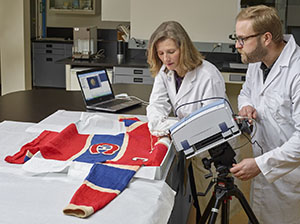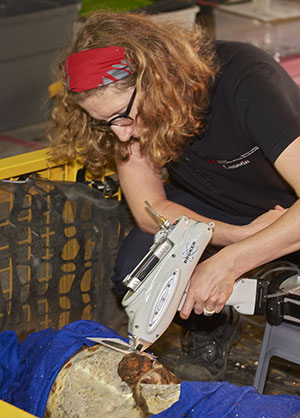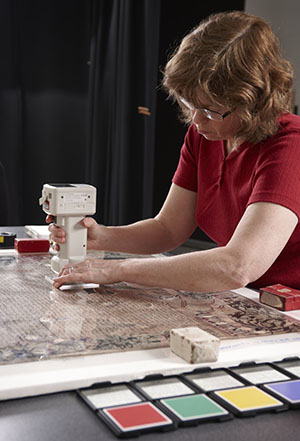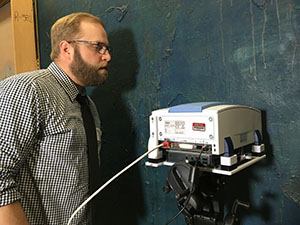On-site scientific services – general information
The Canadian Conservation Institute (CCI) offers a wide range of on-site services, including on-site non-destructive testing for the characterization of materials. CCI staff can help you design and implement an effective monitoring system.
Testing services available on-site include:
- determination of the presence of inorganic pesticide residues by X-ray fluorescence (XRF) spectrometry (consult XRF spectrometry services for more information);
- determination of the chemical composition of objects or materials by Fourier transform infrared (FTIR) spectroscopy;
- characterization of reflective colour or gloss using portable chroma meters, spectrophotometers or gloss meters;
- matching of colour to Munsell colour system standards or other commercial standards;
- assessment of wood degradation; and
- microfade testing.
Information from on-site testing
The information provided by on-site testing can be applied in a number of ways:
- substances in collections that could be health hazards can be identified immediately;
- the identification of the chemical composition of museum objects can aid in choosing conservation treatments and storage methods, as well as in detecting imitation and substitute materials;
- colour measurements allow documentation or colour matching, as well as monitoring of stability during exhibition, storage, conservation treatment and natural weathering;
- the characterization of properties such as colour gloss can be useful in monitoring the durability and service lifetime of protective coatings;
- the assessment of wood degradation can help to determine the stability and condition prior to treatment; and
- microfade testing can identify objects that are at high risk of damage from exposure to light.
On-site testing on materials and objects
On-site testing can be conducted on diverse materials and objects. These include:
- technological and scientific objects;
- natural history specimens;
- industrial and military objects;
- works of art, textiles, paper, paintings, sculptures and architectural elements;
- modern materials;
- household plastic objects, such as dinnerware;
- plastic costume accessories and jewellery;
- coatings and adhesives;
- paint, varnish and wood; and
- corroded metal and metal patina.
Benefits
On-site testing offers unique benefits. The objects need not be moved from their museum location. They can be analyzed directly on gallery walls or in display cases, storage cabinets and drawers, thereby eliminating shipping costs, damage during transport and time lost for packing and moving objects. In some cases, no samples are required and there is no physical contact with the object.

Chemical analysis of a historic hockey sweater using a portable FTIR spectrometer.

On-site elemental analysis of an archaeological metal object using a handheld XRF spectrometer.

Using a portable spectrophotometer to measure the colour on a parchment document.

On-site chemical analysis of a painting using a portable FTIR spectrometer.